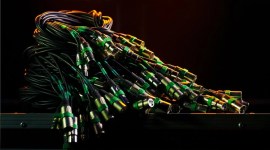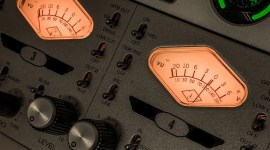
Sonic Space: How To Utilize It In Your Video Projects
Have you thought about sonic space in your sound design? Bring your sound to cinema-quality heights using tools built into most NLEs.
In sound design, the main priority is to create a sound world that’s believable and immersive. This includes the dialogue, foley sound effects, and music. All these elements contribute to the many layers of sound built within the on-screen story world. These all contribute to the sonic space.
What is Sonic Space?
So, what is sonic space? In this case, we are referring to the sonic space in the story world of a film. Bringing the literal sonic environment of a movie into the audience’s perspective will allow it to sound like they are there. But how do we achieve this?
Stereo Field
The stereo field is the concept of creating a sonic soundscape that replicates what our ears perceive. When we hear a sound, our brains can locate and figure out the distance of the sound source. This can be replicated when in the mixing stage of post-production. All films and video projects (except for 3D virtual reality content, but we will get into this later) are mixed in stereo. Mixed correctly gives a more realistic representation of the sound environment. In music, it’s the same as wanting to achieve the organic sound of a live performance.
To achieve a good sense of sonic space, we must utilize the stereo field to our full advantage. Rather than keeping everything in the center of the stereo field, we use the panning mechanism. This allows us to control certain sounds across the stereo field, both left and right.
Usually, when sound mixing, your panning meter will be set to the center, but this can be changed. By panning your sound to the left or right, the sound world becomes wider to our ears as it emulates real-life sonic space on the screen. Here are a few sound elements to consider when handling the stereo field.
Ambient Sound
For setting the scene, using ambient drone sounds or soundscapes can provide the foundation of the sonic environment. The characteristics of ambient drones include very slow-developing sounds. In musical terms, there would be sustained tones and very little rhythmic movement. Ambient drones also provide sonic textures, which in turn create a certain mood.
A drone could sound quite scary and have dissonance, or something that sounds dreamy and light. Either way, ambient drones can set the scene and give the audience an idea of the kind of world they are about to enter. This scene from Denis Villeneuve’s Arrival shows the unidentified pods’ first contact. The music is mainly comprised of drone sounds, very low but textural. The low rumbles and harsh sounds come together to convey the feeling of uncertainty.
Sound Effects
This is where we can start to play around with the panning. When considering sound effects and dialogue, there is more scope to create a more immersive dimension.
Sound effects are either foley sound effects made by foley artists in post-production or artificial sound effects such as lasers. Panning them to the left or right in conjunction with where the sound source is coming from on-screen widens the stereo field.
In this video example from Zed Marty, he shows the foley sounds of a bike and the rustling of leaves for a specific shot. He discusses how when we see the wide shot of the person on the bike coming from the left, the sound is then panned to the left and is automated to go across to the center. Additionally, he talks about volume automation to create depth. When the subject is further away, the sound will be further away.
Simply adjusting the volume down a notch, in line with the panning, can create a more believable sound space. It’s also important to note that you want to avoid hard cuts between your sound effects. Adding a fade will make it smoother.
Dialogue
Most of the time, the dialogue will be in the center when the characters are visible on-screen. Think about when the audience is watching in the cinema. If the dialogue comes from the left, the people sitting on the room’s right won’t get the same effect.
In some cases, panning the dialogue can have a great effect. The video below from Film Sound Tutorials shows an example of a split-screen scene. Slightly panning each character to their corresponding position can bring that scene more to life.
You may have a scene where a character is audibly speaking while it then cuts to another shot of another character. Panning them across the stereo field can show separation.
Interstellar, directed by Christopher Nolan, has a great scene with a clever use of panning in dialogue (and sound effects). Tars, one of the robots, is being detached from the Endurance ship to enter the black hole. Case, the other robot, is communicating with the Tars, so when Case is speaking and cuts to Tars, the dialogue is then panned to the left. Doing so accentuates the separation between the characters and using space.
It’s also important to note the background noise that’s going on here. The sounds are swimming around the stereo field; not all the sounds heard are completely central. A trick that musicians use in music production is layering tracks and panning each one to the right, left, and center. This is to widen the sonic space. The same thing occurs here. Having multiple different sounds going around the stereo field creates a much more immersive feel to the environment.
Audio Effects to Elevate Sonic Space
With the panning and volume automation to heighten the sonic space, using audio effects can add extra color and depth. Reverb and Delay are common effects used to convey a particular space, but they also can be used for dramatic effect.
Mad Max: Fury Road, directed by George Miller, has some amazing sound design. From the opening scene, the off-screen dialogue is again swimming around the stereo field with the main protagonist at the center.
The use of reverb also provides a sense of space. The little girl’s voice not only has reverb but a delay effect too. When she says, “were are you,” it delays using a ping pong effect (or a stereo echo), going from each side.
When the car revs its engine and drives away, because the wheel in focus is on the left, the sound of the wheel spin is panned slightly to the left and moves to the center as it drives away. The next shot sees multiple vehicles coming from alternating sides.
Again the sound designer has slightly panned each vehicle to its corresponding side. Combined with volume automation and other audio editing tools like an Equalizer (EQ), this places those sounds perfectly in the space.
Three-Dimensional Sound
With the rise of Virtual Reality experiences, mixing in stereo becomes very limiting. As stereo is more two-dimensional, sound engineers working on VR will tend to use an ambisonic sound field. This is where the polar pattern is 360°. Furthermore, ambisonics replicates our own natural hearing.
Ambisonic audio provides way more versatility when it comes to creating immersion in sound due to visual freedom. Being able to explore in virtual reality comes with more freedom to explore sound. Ambisonic microphones make field recordings of natural environments so that when you are placed in a space, the sound is heard as if you were there.
360° videos can easily be sourced online for those who don’t have a VR headset. Sound engineers will have in place an ambisonic field recording or a piece of music for the viewer to listen to through headphones. With spatial audio and dynamic head tracking, you can get the full 360° experience when moving around the space on the screen, and in virtual reality too!
Have a little experiment with your sound effects and music within your video projects. By playing around with the panning and volume automation—as well as some reverb, delay, or EQ—can ultimately bring even more life to your content. The best advice to give is also to hone your listening skills. Going outside to listen to nature sounds or being aware of how sounds from various sources move across the space can also help the creative process.
PremiumBeat Sound Effects
Throughout this list, we linked to a recent roundup of ambisonic microphones. However, with their steep price point and the additional need for a four-channel mixer, obtaining ambisonic sound effects isn’t as practical as written. Or is it?
On PremiumBeat, you can find over 16,000 sound effects, all available in stereo, 5.1, and ambisonic. These high-quality, immersive SFX can be used in a variety of projects, like AR/VR, game streaming/development, immersive films, ad videos, documentaries, and events. You now have the lowdown on using audio in sonic space, so you just need the sound effects. Check them out here.
Cover image via Frame Stock Footage.
For more on audio, check out these articles.





